Spring Boot 教程:构建 RESTful Web 服务
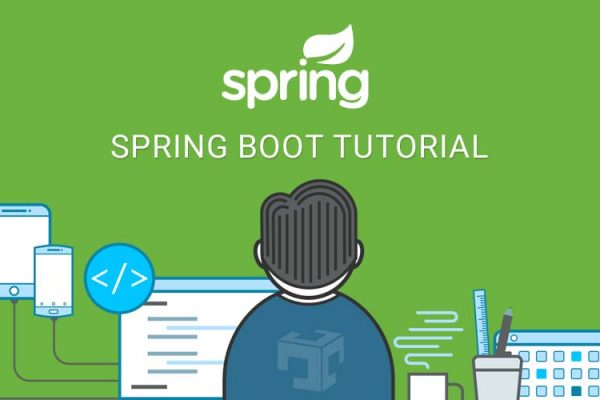
Spring Boot 提供了构建企业应用中 RESTful Web 服务的极佳支持。本文为你详解如何使用 Spring Boot 构建 RESTful web 服务。
注意:要构建 RESTful Web 服务,我们需要在构建配置文件中加上 Spring Boot Starter Web 依赖。
对于 Maven 用户,使用以下的代码在 pom.xml 文件中加入依赖:
1 <dependency> 2 <groupId>org.springframework.boot</groupId> 3 <artifactId>spring-boot-starter-web</artifactId> 4 </dependency>
对于 Gradle 用户,使用以下的代码在 build.gradle 文件中加入依赖:
compile('org.springframework.boot:spring-boot-starter-web')
完整的构建配置文件 Maven build – pom.xml 如下:
1 <?xml version = "1.0" encoding = "UTF-8"?> 2 <project xmlns = "http://maven.apache.org/POM/4.0.0" 3 xmlns:xsi = "http://www.w3.org/2001/XMLSchema-instance" 4 xsi:schemaLocation = "http://maven.apache.org/POM/4.0.0 5 http://maven.apache.org/xsd/maven-4.0.0.xsd"> 6 7 <modelVersion>4.0.0</modelVersion> 8 <groupId>com.tutorialspoint</groupId> 9 <artifactId>demo</artifactId> 10 <version>0.0.1-SNAPSHOT</version> 11 <packaging>jar</packaging> 12 <name>demo</name> 13 <description>Demo project for Spring Boot</description> 14 15 <parent> 16 <groupId>org.springframework.boot</groupId> 17 <artifactId>spring-boot-starter-parent</artifactId> 18 <version>1.5.8.RELEASE</version> 19 <relativePath/> 20 </parent> 21 22 <properties> 23 <project.build.sourceEncoding>UTF-8</project.build.sourceEncoding> 24 <project.reporting.outputEncoding>UTF-8</project.reporting.outputEncoding> 25 <java.version>1.8</java.version> 26 </properties> 27 28 <dependencies> 29 <dependency> 30 <groupId>org.springframework.boot</groupId> 31 <artifactId>spring-boot-starter-web</artifactId> 32 </dependency> 33 <dependency> 34 <groupId>org.springframework.boot</groupId> 35 <artifactId>spring-boot-starter-test</artifactId> 36 <scope>test</scope> 37 </dependency> 38 </dependencies> 39 40 <build> 41 <plugins> 42 <plugin> 43 <groupId>org.springframework.boot</groupId> 44 <artifactId>spring-boot-maven-plugin</artifactId> 45 </plugin> 46 </plugins> 47 </build> 48 49 </project>
完整的构建配置文件 Gradle Build – build.gradle 如下:
1 bbuildscript { 2 ext { 3 springBootVersion = '1.5.8.RELEASE' 4 } 5 repositories { 6 mavenCentral() 7 } 8 dependencies { 9 classpath("org.springframework.boot:spring-boot-gradle-plugin:${springBootVersion}") 10 } 11 } 12 13 apply plugin: 'java' 14 apply plugin: 'eclipse' 15 apply plugin: 'org.springframework.boot' 16 17 group = 'com.tutorialspoint' 18 version = '0.0.1-SNAPSHOT' 19 sourceCompatibility = 1.8 20 21 repositories { 22 mavenCentral() 23 } 24 dependencies { 25 compile('org.springframework.boot:spring-boot-starter-web') 26 testCompile('org.springframework.boot:spring-boot-starter-test') 27 }
在继续构建 RESTful web 服务前,建议你先要熟悉下面的注解:
Rest Controller
@RestController 注解用于定义 RESTful web 服务。它提供 JSON、XML 和自定义响应。语法如下所示:
1 @RestController 2 public class ProductServiceController { 3 }
Request Mapping
@RequestMapping 注解用于定义请求 URI 以访问 REST 端点。我们可以定义 Request 方法来消费 produce 对象。默认的请求方法是 GET:
1 @RequestMapping(value = "/products") 2 public ResponseEntity<Object> getProducts() { }
Request Body
@RequestBody 注解用于定义请求体内容类型。
1 public ResponseEntity<Object> createProduct(@RequestBody Product product) { 2 }
Path Variable
@PathVariable 注解被用于定义自定义或动态的请求 URI,Path variable 被放在请求 URI 中的大括号内,如下所示:
1 public ResponseEntity<Object> updateProduct(@PathVariable("id") String id) { 2 }
Request Parameter
@RequestParam 注解被用于从请求 URL 中读取请求参数。缺少情况下这是一个必需的参数,也可以为请求参数设置默认值,如下所示:
1 public ResponseEntity<Object> getProduct( 2 @RequestParam(value = "name", required = false, defaultValue = "honey") String name) { 3 }
GET API
默认的 HTTP 请求方法是 GET。这个方法不需要任何请求体。你可以通过发送请求参数和路径变量来定义自定义或动态 URL。
下面的示例代码定义了 HTTP GET 请求方法。在这个例子吧,我们使用 HashMap 来在存储 Product。注意我们使用了 POJO 类来存储产品。
在这里,请求 URI 是 /products,它会从 HashMap 仓储中返回产品列表。下面的控制器类文件包含了 GET 方法的 REST 端点:
1 package com.tutorialspoint.demo.controller; 2 3 import java.util.HashMap; 4 import java.util.Map; 5 6 import org.springframework.http.HttpStatus; 7 import org.springframework.http.ResponseEntity; 8 import org.springframework.web.bind.annotation.RequestMapping; 9 import org.springframework.web.bind.annotation.RestController; 10 11 import com.tutorialspoint.demo.model.Product; 12 13 @RestController 14 public class ProductServiceController { 15 private static Map<String, Product> productRepo = new HashMap<>(); 16 static { 17 Product honey = new Product(); 18 honey.setId("1"); 19 honey.setName("Honey"); 20 productRepo.put(honey.getId(), honey); 21 22 Product almond = new Product(); 23 almond.setId("2"); 24 almond.setName("Almond"); 25 productRepo.put(almond.getId(), almond); 26 } 27 @RequestMapping(value = "/products") 28 public ResponseEntity<Object> getProduct() { 29 return new ResponseEntity<>(productRepo.values(), HttpStatus.OK); 30 } 31 }
POST API
HTTP POST 请求用于创建资源。这个方法包含请求体。我们可以通过发送请求参数和路径变量来定义自定义或动态 URL。
下面的示例代码定义了 HTTP POST 请求方法。在这个例子中,我们使用 HashMap 来存储 Product,这里产品是一个 POJO 类。
这里,请求 URI 是 /products,在产品被存入 HashMap 仓储后,它会返回字符串。
1 package com.tutorialspoint.demo.controller; 2 3 import java.util.HashMap; 4 import java.util.Map; 5 6 import org.springframework.http.HttpStatus; 7 import org.springframework.http.ResponseEntity; 8 import org.springframework.web.bind.annotation.RequestBody; 9 import org.springframework.web.bind.annotation.RequestMapping; 10 import org.springframework.web.bind.annotation.RequestMethod; 11 import org.springframework.web.bind.annotation.RestController; 12 13 import com.tutorialspoint.demo.model.Product; 14 15 @RestController 16 public class ProductServiceController { 17 private static Map<String, Product> productRepo = new HashMap<>(); 18 19 @RequestMapping(value = "/products", method = RequestMethod.POST) 20 public ResponseEntity<Object> createProduct(@RequestBody Product product) { 21 productRepo.put(product.getId(), product); 22 return new ResponseEntity<>("Product is created successfully", HttpStatus.CREATED); 23 } 24 }
PUT API
HTTP PUT 请求用于更新已有的资源。这个方法包含请求体。我们可以通过发送请求参数和路径变量来定义自定义或动态 URL。
下面的例子展示了如何定义 HTTP PUT 请求方法。在这个例子中,我们使用 HashMap 更新现存的产品。此处,产品是一个 POJO 类。
这里,请求 URI 是 /products/{id},在产品被存入 HashMap 仓储后,它会返回字符串。注意我们使用路径变量 {id} 定义需要更新的产品 ID:
1 package com.tutorialspoint.demo.controller; 2 3 import java.util.HashMap; 4 import java.util.Map; 5 6 import org.springframework.http.HttpStatus; 7 import org.springframework.http.ResponseEntity; 8 import org.springframework.web.bind.annotation.PathVariable; 9 import org.springframework.web.bind.annotation.RequestBody; 10 import org.springframework.web.bind.annotation.RequestMapping; 11 import org.springframework.web.bind.annotation.RequestMethod; 12 import org.springframework.web.bind.annotation.RestController; 13 import com.tutorialspoint.demo.model.Product; 14 15 @RestController 16 public class ProductServiceController { 17 private static Map<String, Product> productRepo = new HashMap<>(); 18 19 @RequestMapping(value = "/products/{id}", method = RequestMethod.PUT) 20 public ResponseEntity<Object> updateProduct(@PathVariable("id") String id, @RequestBody Product product) { 21 productRepo.remove(id); 22 product.setId(id); 23 productRepo.put(id, product); 24 return new ResponseEntity<>("Product is updated successsfully", HttpStatus.OK); 25 } 26 }
DELETE API
HTTP Delete 请求用于删除存在的资源。这个方法不包含任何请求体。我们可以通过发送请求参数和路径变量来定义自定义或动态 URL。
下面的例子展示如何定义 HTTP DELETE 请求方法。这个例子中,我们使用 HashMap 来移除现存的产品,用 POJO 来表示。
请求 URI 是 /products/{id} 在产品被从 HashMap 仓储中删除后,它会返回字符串。 我们使用路径变量 {id} 来定义要被删除的产品 ID。
1 package com.tutorialspoint.demo.controller; 2 3 import java.util.HashMap; 4 import java.util.Map; 5 6 import org.springframework.http.HttpStatus; 7 import org.springframework.http.ResponseEntity; 8 import org.springframework.web.bind.annotation.PathVariable; 9 import org.springframework.web.bind.annotation.RequestBody; 10 import org.springframework.web.bind.annotation.RequestMapping; 11 import org.springframework.web.bind.annotation.RequestMethod; 12 import org.springframework.web.bind.annotation.RestController; 13 14 import com.tutorialspoint.demo.model.Product; 15 16 @RestController 17 public class ProductServiceController { 18 private static Map<String, Product> productRepo = new HashMap<>(); 19 20 @RequestMapping(value = "/products/{id}", method = RequestMethod.DELETE) 21 public ResponseEntity<Object> delete(@PathVariable("id") String id) { 22 productRepo.remove(id); 23 return new ResponseEntity<>("Product is deleted successsfully", HttpStatus.OK); 24 } 25 }
下面给出完整的源代码:
Spring Boot 主应用类 – DemoApplication.java
1 package com.tutorialspoint.demo; 2 3 import org.springframework.boot.SpringApplication; 4 import org.springframework.boot.autoconfigure.SpringBootApplication; 5 6 @SpringBootApplication 7 public class DemoApplication { 8 public static void main(String[] args) { 9 SpringApplication.run(DemoApplication.class, args); 10 } 11 }
POJO 类 – Product.java
1 package com.tutorialspoint.demo.model; 2 3 public class Product { 4 private String id; 5 private String name; 6 7 public String getId() { 8 return id; 9 } 10 public void setId(String id) { 11 this.id = id; 12 } 13 public String getName() { 14 return name; 15 } 16 public void setName(String name) { 17 this.name = name; 18 } 19 }
Rest Controller 类 – ProductServiceController.java
1 package com.tutorialspoint.demo.controller; 2 3 import java.util.HashMap; 4 import java.util.Map; 5 6 import org.springframework.http.HttpStatus; 7 import org.springframework.http.ResponseEntity; 8 import org.springframework.web.bind.annotation.PathVariable; 9 import org.springframework.web.bind.annotation.RequestBody; 10 import org.springframework.web.bind.annotation.RequestMapping; 11 import org.springframework.web.bind.annotation.RequestMethod; 12 import org.springframework.web.bind.annotation.RestController; 13 14 import com.tutorialspoint.demo.model.Product; 15 16 @RestController 17 public class ProductServiceController { 18 private static Map<String, Product> productRepo = new HashMap<>(); 19 static { 20 Product honey = new Product(); 21 honey.setId("1"); 22 honey.setName("Honey"); 23 productRepo.put(honey.getId(), honey); 24 25 Product almond = new Product(); 26 almond.setId("2"); 27 almond.setName("Almond"); 28 productRepo.put(almond.getId(), almond); 29 } 30 31 @RequestMapping(value = "/products/{id}", method = RequestMethod.DELETE) 32 public ResponseEntity<Object> delete(@PathVariable("id") String id) { 33 productRepo.remove(id); 34 return new ResponseEntity<>("Product is deleted successsfully", HttpStatus.OK); 35 } 36 37 @RequestMapping(value = "/products/{id}", method = RequestMethod.PUT) 38 public ResponseEntity<Object> updateProduct(@PathVariable("id") String id, @RequestBody Product product) { 39 productRepo.remove(id); 40 product.setId(id); 41 productRepo.put(id, product); 42 return new ResponseEntity<>("Product is updated successsfully", HttpStatus.OK); 43 } 44 45 @RequestMapping(value = "/products", method = RequestMethod.POST) 46 public ResponseEntity<Object> createProduct(@RequestBody Product product) { 47 productRepo.put(product.getId(), product); 48 return new ResponseEntity<>("Product is created successfully", HttpStatus.CREATED); 49 } 50 51 @RequestMapping(value = "/products") 52 public ResponseEntity<Object> getProduct() { 53 return new ResponseEntity<>(productRepo.values(), HttpStatus.OK); 54 } 55 }
你可以创建可执行的 JAR 文件,使用以下的 Maven 或 Gradle 命令来运行 spring boot 应用:
Maven命令如下:
mvn clean install
“构建成功“后,可以在 target 文件夹下发现 JAR 文件。
Gradle命令如下:
gradle clean build
“构建成功“后,可以在 build/libs 文件夹下发现 JAR 文件。
可以使用以下命令来运行 JAR 文件:
java –jar <JARFILE>
以 Tomcat 端口号 8080 启动应用,如下所示:

在 POSTMAN 应用中点击下面的 URL 可以看到相应的输出:
GET API URL 为: http://localhost:8080/products
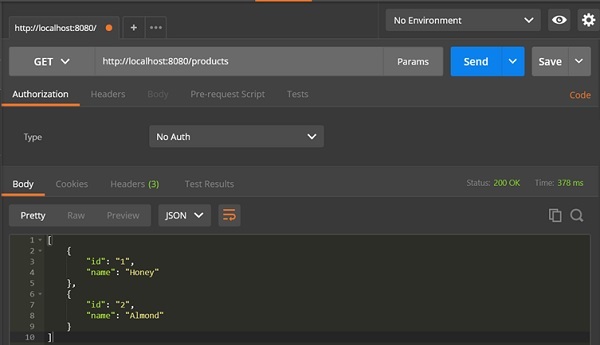
POST API URL 为: http://localhost:8080/products
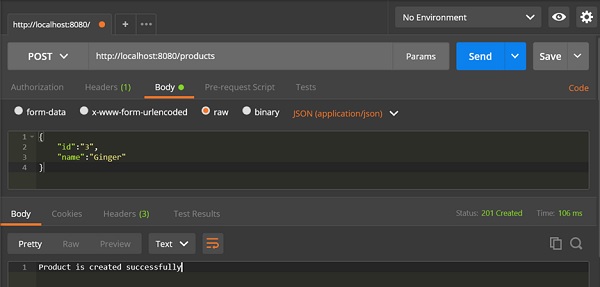
PUT API URL 为: http://localhost:8080/products/3
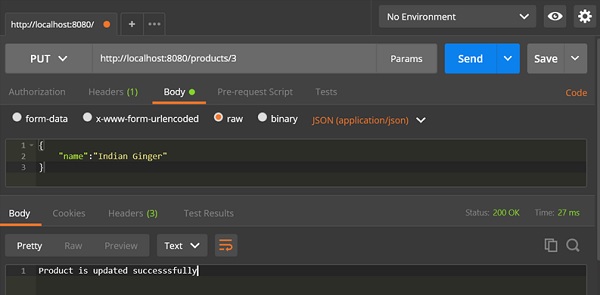
DELETE API URL 为: http://localhost:8080/products/3
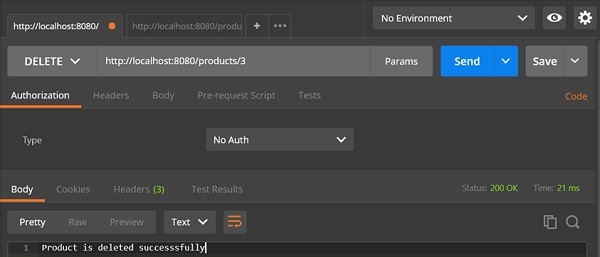




 浙公网安备 33010602011771号
浙公网安备 33010602011771号